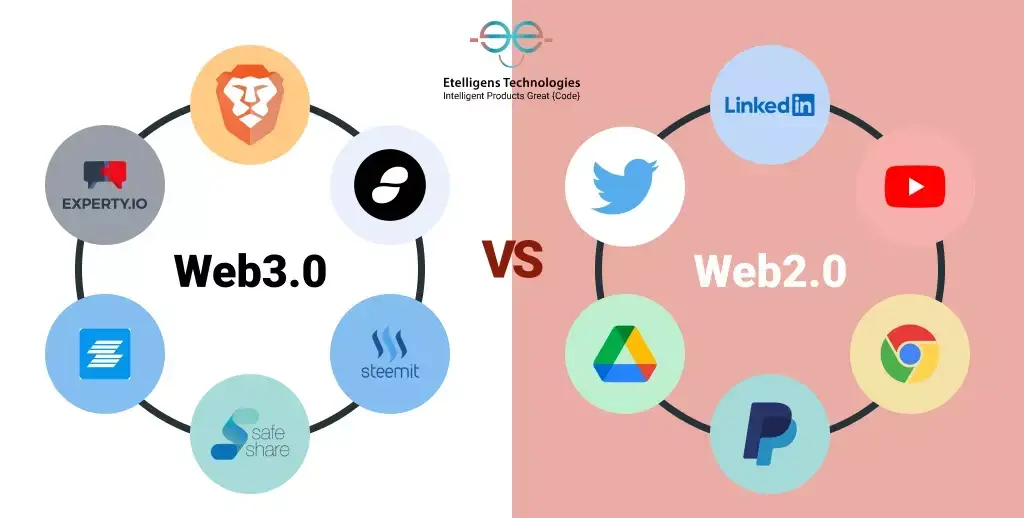In blockchain technology, two notable terms that many users have come across are Web 3.0 and Web 2.0. However, both of these are specific terms related to internet services. After Web 1.0, which mainly had static websites and limited user generation features, Web 2.0 and Web 3.0 technology are newer versions.
Both solutions have varying benefits, especially in the context of user interaction. To see them in the light of cryptocurrencies and blockchain technology, you need to understand both well. In this article, we cover the differences in detail.
What is Web 3.0?
Web 3.0, on the other hand, is a more robust version that focuses on fixing the challengers of Web 2.0. The 2.0 version does not have the best security benefits in terms of transactions and personal data. The 3.0 version has a better infrastructure and security technology, useful in the web 3.0 crypto market.
Web 3.0 tech is also known as the semantic web that focuses on an advanced metadata system. This arranges and structures the different types of data of users and makes them readable.
Therefore, the technology ensures a universal distribution of data across platforms and safer transactions. It is seen that the web 3.0 tokens on the blockchain have exceeded every expectation, especially when compared to altcoin and Bitcoin.
What is Web 2.0?
Web 2.0 technology mainly related to the second-generation internet services after the initial static website-heavy version. To note, developers focused on creating a solution that allowed easier user interaction with web content.
Therefore, this Web 2.0 centered around improving usability and interoperability with user-generated content for all end users.
Here, the focus is not on technical modifications. Instead, Web 2.0 centers around adapting the web page designs and how to utilize them through P2P-based interactions and collaborations. Social media platforms and e-commerce websites mostly center on this type, like Twitter and Facebook.
Statistically, the former has around 500 million active users, and the latter has approximately 800 million active users.

Difference: Web 2.0 vs 3.0
Here are the main differences between Web 2.0 and Web 3.0 Blockchain specifically.
Focus
The significant difference that separates web 2.0 from web 3.0 is their primary focus. On one side, web 2.0 is focused on establishing user interaction with content on the internet. In contrast, web 3.0 makes itself an active participant in the content on the web by immersing itself in it.
Another point to consider is where web 3.0 aims to connect with knowledge; web 2.0 aims to connect with people. Speaking broadly, web 2.0 focuses mainly on tagging and improving the end-user experience.
In contrast, web 3.0 focuses on user empowerment by improving security, trust, and privacy. So, you can acknowledge that focus is a notable area to consider when comparing web 2.0 and web 3.0.
Usage
One of the most crucial differences is between the usage of web 2.0 and web 3.0 services. Web 2.0 is a second-generation internet service solely focused on interaction. Web 3.0, on the other hand, is the next-generation internet service that emphasizes semantics and decentralization.
Therefore, it aims to understand the differences between users and machines using decentralized infrastructure for a better crypto transaction experience.
Types of applications
When finding the difference between web 2.0 and web 3.0, one must also discuss the types of applications. For example, most web 2.0 applications involve two-way web pages, podcasts, video websites, and personal blogs.
In contrast, web 3.0 looks after the growth of intelligent apps while leveraging AI and ML functionalities. Some of its examples include 3D portals, multi-user virtual environments, and integrated games.
Features
In terms of features, web 2.0 enables better interaction between web applications with a wide range of features. Also, it requires interactive advertising. On the other hand, web 3.0 deals with behavioral marketing.
Therefore, they offer innovative web-based applications and functionalities. In addition, web 3.0 establishes a perfect blend of web knowledge and technologies.
Technologies
The most important differentiating factor is the underlying technologies. In terms of its contribution to the introduction of many new technologies, web 2.0 is undeniably powerful. Some of the technologies that show the tremendous growth of web 2.0 are JavaScript and AJAX.
Apart from this, you can also find HTML5 and CSS3 empowering web 2.0 technology. As far as web 3.0 is concerned, it supports the implementation of innovative techs.
The major areas that act as the foundation of web 3.0 technologies are semantic web, AI, and decentralized protocols. Other notal technologies empowering growth include ontologies and knowledge bases.
State of data
Data ownership is another essential difference between web 3.0 and web 2.0. Web 2.0, on the one hand, takes ownership of the data. Web 3.0, on the other hand, implies the right of data and flexibility in data sharing through the network.
Conclusion
The different factors of comparison clearly show how web 3.0 has a higher advantage over web 2.0.
But truth to be told, there are still many standards of web 3.0 that are yet to be unfolded. This is because the artificial intelligence and semantic web technology part of web 3.0 are still early and will develop more with time. Nevertheless, many companies are working on it right now to reach its true potential.